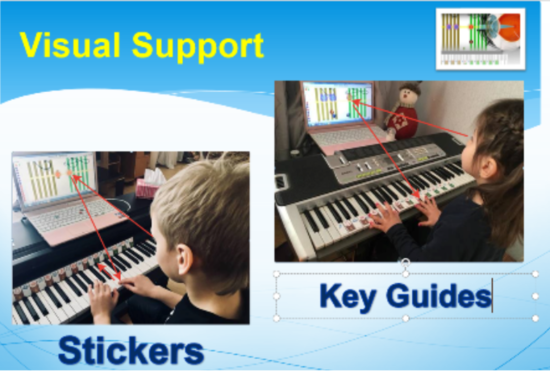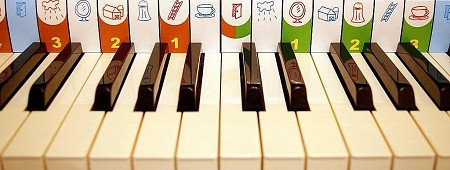Preparatory C (from 5+). Lesson 44

Your FREE Demo version is here
Your full version access is here
Do you understand better now that your toddler's attention is energy and any 'leaks' weakens this source?
Internet is overloaded with the pictures of inattentive students at the pianos. If a child on a picture or a video wonders around and looking anywhere else, but keys and music notes, his attention is under risk of loosing all energy to the point of complete frustration and lose of interest. 
To avoid this from happening you as an instructor should let your child
To See the Key
In order to find the key that corresponds to a specific note, a student has to physically transfer visual focus from the music notation space to that of a keyboard. This is not an easy “project” for an untrained eye.
A synthesizer with stickers is the most convenient way of finding the keys, as the picture with the name of the note is right at the fingertips of a player. That is why it is best to use stickers for presentations and initial lessons with beginners.
As I previously mentioned, even in this case students might not be able to see and identify the desired key right away. To make it easier on the eye and to release attention, we can partially cover the keyboard or computer screen.
If a child finds the right key quickly, you can gradually make the task more difficult.
Once a child learns to shift his focus from music notation to the key, it's time to start working on a piano piece.
The best way to do it is to take a short passage of a piano piece, between 4 and 8 notes in length, and ask him to play it.
If playing time on the timer interval does not exceed the amount of notes played (for example, 4 notes played in 3 seconds), the attention of your child is ready for further development of the focal concentration.
Synthesizer with tabs (Key Guides) requires more attention: the student must shift visual focus from the music note to the picture and make sure that the picture corresponds to the key.

As a rule, the timer of the Gentle Piano immediately reflects this seemingly minor complication – the rate of delay increases. It tells us that attention has partially shifted towards solving physical problems.
Stickers can be replaced by music tabs (Piano Key Guides) once the student can play piano pieces at low rates of delay, almost without looking at his hands.
Using the keys without stickers and tabs is the most complex problem for a beginner. As a rule, the attention is directed towards solving physical problems:
- to see what to play,
- to find what to press, and
- to decide how much force to apply.
There are different methods that allow the novice to see the note and the key with “traditional” music notation and bare keys: white key search by location of black keys; memorizing the position of each note, and teacher’s tips. As stated earlier, these methods lead to attention overload.
If a student needs more than a second to find a note and a key, his attention is working overtime. Not only it doesn’t accumulate energy, it actually depletes it.
1. We improve the game of the scale of Ganon's exercise No. 1 with separate and two hands with a metronome.
2.We play at a slow pace. We try to play even sounds, remember the exercises of O.M. Egorova and watch your hand and elbows.
3.We call (sing) notes at an average and faster pace, playing with a metronome.
This is the last week of work on Ganon #1. Try to make the best result and record on video Don't forget to post the video in the progress diary.
If possible, repeat the exercises of the previous lessons.
Acquaintance with the third letter from the "the "Kingdom of Tune""
Queen Tonic: The Adventures of the Princess Briefcase Continue!
- dominant second.
- Playing in C Major Fixing the subdominant key.
- Playing in C Major Introduction to Stage V.
- Playing in C Major I - Tonic key.
- Playing in C Major Tonic fifth. Playing in C Major
Video example of working with the third letter:

If your child is growing faster or slower than our plans suggest, we encourage you to contact us at admin@softmozart.com to start learning with our certified professionals.
1.  Gentle Piano®- New piece to perform - Album Favorite Classic 1 - Ode to Joy: R - RH, L - LH и P
Gentle Piano®- New piece to perform - Album Favorite Classic 1 - Ode to Joy: R - RH, L - LH и P
Let's start learning the piece by heart. Sing the right hand solfeggio melody like the cartoon characters from the last lesson. This will help you memorize the music faster.
Be sure to play each hand 2 times and check the number of errors and the time gap.
2.  Gentle Piano®- Reading from a sheet. First Steps: Fingerobics #8
Gentle Piano®- Reading from a sheet. First Steps: Fingerobics #8
Playing R, L and P on 2, 4, 5, 6
3. Repeat all previous plays.
TEASER:  Gentle Piano® - more complex version "Ode to Joy" in Album Favorite Classic 1 - Ode to Joy: R, L, P, RH, LH
Gentle Piano® - more complex version "Ode to Joy" in Album Favorite Classic 1 - Ode to Joy: R, L, P, RH, LH
And a lighter one in Introductory Songs 0. Played with two hands.
We find other interpretations of the work on the Internet and listen - we look.
Это - последняя неделя работы с этим произведением. Обязательно сделайте фото или видео и поставьте в свой дневник прогресса.
Visit our Soft Mozart forum and start your progress diary here. Use the current year section. This is the place for you to ask questions and share your experiences.
At least 2 photos and 1-2 videos of the listed activities will count towards your child's credits for the graduation DIPLOMA. Please upload the video to You Tube, copy the address from the BROWSER window and paste it into your Progress Diary. Do not forget to indicate the year and type of work in the description of your Soft Mozart Academy photo / video.
Sincerely Yours,
Hellene Hiner

Video success:
 Would you like to receive lessons by email weekly? Subscribe to the e-mail lesson here:
Would you like to receive lessons by email weekly? Subscribe to the e-mail lesson here:
All the lesson plans:
For 2+ students
For students from 3 to 5
For students 5+
Always check here, if we have any recital! You and your child will benefit a lot from participating in our concerts!
Your place to start your progress diary is here.



